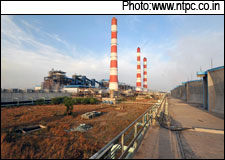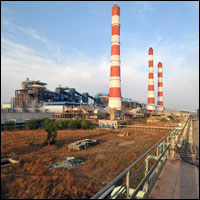Fiscal 2014 ended on an encouraging note in power generation, even as capacity augmentation fell a little short of the feat in FY13. The total power requirement in the country crossed the one-trillion unit mark for the first time during the year. However, it followed only a marginal rise over the year, reflecting stagnation in industry and steep economic deceleration on one hand and 5.6 per cent appreciable increase in ex-bus power availability on the other. Power deficit fell to 4.2 per cent, half the shortage in the previous fiscal.
The per capita power consumption assessed at 917 kWh during 2012-13, up annually by 3.8 per cent, is around a fifth of that in China or 20th of the level in USA.
 The total power generating capacity increased 19,685 MW during the year, according to CEA compilation, against 23,467 MW in FY13. While thermal and renewable energy sources, whose data is supplied by the Ministry of New and Renewable Energy, showed lower growth, capacity addition in hydropower at 1,040 MW was twice the increment during the earlier year. Nuclear power drew a blank for the second year. The total capacity addition of 43,152 MW during the first two years of the ongoing 12th Plan, about 36 per cent of capacity augmentation targeted for the plan period, was vastly better than 15,636 MW added during the first two years, or about 23 per cent fulfillment in the 11th Plan.
The total power generating capacity increased 19,685 MW during the year, according to CEA compilation, against 23,467 MW in FY13. While thermal and renewable energy sources, whose data is supplied by the Ministry of New and Renewable Energy, showed lower growth, capacity addition in hydropower at 1,040 MW was twice the increment during the earlier year. Nuclear power drew a blank for the second year. The total capacity addition of 43,152 MW during the first two years of the ongoing 12th Plan, about 36 per cent of capacity augmentation targeted for the plan period, was vastly better than 15,636 MW added during the first two years, or about 23 per cent fulfillment in the 11th Plan.
|
|||||||||||||||||||||||||
Installed capacity
The total grid-connected installed capacity at the end of FY14 was placed at 243,029 MW comprising 29,463 MW (12 per cent) from rapidly rising non-conventional renewable power and 88 per cent from conventional power; thermal power, bulk of it coal-fired, constituted four-fifth, large hydro 20 per cent and nuclear just around 2 per cent of conventional power. The share of non-conventional energy, which comprises small hydropower, wind power, solar power, biomass/biogas and industrial/urban waste, has doubled from around 6 per cent six to seven years ago. Captive generation capacity in industries having demand of 1 MW and above, grid interactive (as on March 31, 2011), has been placed at 34,444.12 MW.
Around 36 per cent of power capacity is in western region followed by 27 per cent in northern region, 24 per cent in southern region, 12 per cent in eastern region, and only 1 per cent in north-eastern and island regions. Western region leads in thermal power and northern region in hydro. Southern region leads in RES, with 45 per cent share in all-India aggregate, followed by western region (34 per cent) and northern region (19 per cent).
Marking a major change from pattern till recently, private sector has increasingly forayed into power infrastructure in recent years. Thus, during the 11th Plan over two-fifth of conventional energy capacity addition was at the behest of private sector, with 32 per cent coming from state government utilities and around 26 per cent from central government power companies. Most of the capacity in private sector was in thermal power with hydropower forming just 5 per cent.
In addition, around nine-tenth of capacity in RES is in private sector. As a result, private sector utilities accounted for 34 per cent of the total grid-connected installed capacity (including RES) in the country at the end of FY14; state government utilities accounted for 38 per cent and central government companies 28 per cent.
|
|||||||||||||||||||||||||||||||||||||
Generation
Power generation increased by 6 per cent during 2013-14. The growth rate, though much better than 4 per cent during fiscal 2013, was less than 8.1 per cent two years ago. Hydropower including that imported from Bhutan JV rose 19 per cent, enabling most of the step-up in the generation rate during the year. Thermal power and nuclear power increased 4 per cent each.
Most of the increase in dominant thermal power seems to have come from additions to capacity. Thus, the PLF at the thermal stations indicative of capacity use ratio declined to 65 per cent, from 70 per cent during fiscal 2013. The decline in PLF happened in all the regions. In fact, barring September, all other months witnessed lower PLF.
Among the ownership categories, private sector IPP that accounted for around a fifth of total power produced during the year increased 28 per cent. Central sector utilities, which accounted for two-fifth of all-India generation, increased it by 2 per cent and state government utilities with a little less than two-fifth share generated 1 per cent more power during the year. Power generation in private sector public utilities showed 9 per cent annual decline.
Most of the increase in hydropower came from plants in western, southern and eastern regions, even as northern region, which accounts for a little less than a half of hydro generation, could increase the output by just 1 to 2 per cent. At aggregate level, generating stations in southern region showed 7.5 per cent increase, in western region 6.8 per cent increase, in eastern region 5.9 per cent and in a minor player north-eastern region 13.6 per cent, which is contributed by mainly thermal plants. The second largest power producer northern region (the first being western region) could increase generation by only 3.7 per cent.
|
POWER GENERATION
|
||
|
Year
|
BU
|
% Increase
|
| 2003-04 |
558.3
|
5.0
|
| 2004-05 |
587.4
|
5.2
|
| 2005-06 |
617.5
|
5.1
|
| 2006-07 |
662.4
|
7.3
|
| 2007-08 |
704.5
|
6.4
|
| 2008-09 |
723.8
|
2.7
|
| 2009-10 |
771.6
|
6.6
|
| 2010-11 |
811.1
|
5.1
|
| 2011-12 |
876.9
|
8.1
|
| 2012-13 |
912.1
|
4.0
|
| 2013-14 |
967.2
|
6.0
|
Power supply
Even as the total power requirement in India crossed the one-trillion unit mark for the first time in 2013-14, it showed only a marginal rise over the preceding year, reflecting stagnating industry and steeply decelerating economy. This together with a 5.6 per cent increase in ex-bus power availability resulted in a sharp decline in power deficit to 4.2 per cent during the year, which is half of the shortage in fiscal 2012-13. Peak demand-peak supply deficit also fell to 4.5 per cent, from 4.6 per cent during fiscal 2012-13 and 9 per cent two years ago.
In fact, reflecting the momentum in economic downturn during the year, the average deficit which was ruling at 8.6 per cent at the end of March 2013, fell to 4.1 per cent in next three months, 3.9 per cent by December and 3.6 per cent by March 2014 (though, erratically, it had gone up to 6.7 per cent in September). Ex-bus power available reflects the total electricity sent out/delivered from generating stations, which would be less than total power generation by, broadly, auxiliary power consumption and transformation losses within the generating stations.
Power deficit eased in fiscal 2013-14 across the country in all the states, which was more due to subdued economic activity than to substantially improved power availability. Northern region, the largest power consumer region for past two years, witnessed 6 per cent deficit, which, though, eased from 9.2 per cent in 2012-13. Uttar Pradesh (14 per cent) and Jammu & Kashmir (22 per cent) largely contributed to the shortage. Southern region had to bear 6.8 per cent power deficiency which comprised 9.5 per cent in Karnataka, 6.9 per cent in Andhra Pradesh and 5.9 per cent in Tamil Nadu. Western region witnessed only a marginal 1 per cent shortage, with all the seven states experiencing negligible deficit.
Maharashtra, the top power consumer state in the country, experienced 2.1 per cent power deficit during 2013-14, slowing from 3.3 per cent in the previous fiscal and 16.7 per cent two years ago. Andhra Pradesh, the second ranked state, faced 6.9 per cent (17.6 per cent) shortage. Uttar Pradesh, the third largest state, faced 14 per cent (16.6 per cent) shortage. Karnataka suffered 9.5 per cent (13.9 per cent) shortage, even as Gujarat was self-sufficient in meeting its power needs for the second year. The top six states which account for 56 per cent of the power consumption in India were responsible for four-fifth of the power deficit in the country.
|
ALL INDIA PLF MONTH-WISE
|
||
|
|
2012-13
|
2013-14
|
| April |
75.24
|
69.97
|
| May |
74.45
|
71.55
|
| June |
72.24
|
63.4
|
| July |
66.96
|
60.86
|
| August |
61.58
|
55.94
|
| September |
61.41
|
64.65
|
| October |
71.04
|
61.85
|
| November |
71.02
|
65.44
|
| December |
72.41
|
69.05
|
| January |
74.33
|
69.82
|
| February |
70.67
|
68.44
|
| March |
71.96
|
66.58
|
T&D
Fiscal 2014 saw addition of 16,748 ckm transmission lines and 57,330 mva under substations, both falling short of 17,107 ckm and 63,665 mva respectively added during the preceding year. The T&D feat in 2013-14 raised the total transmission capacity to 1,44,851 ckm in 220kV, 1,25,957 ckm in 400kV, 11,096 ckm in 765kV and 9,432 ckm in HVDC. The total MVA capacity at substations stood at 5,17,046 at the end of fiscal 2014.
|
DEFICIT IN TOP SIX POWER CONSUMER STATES DURING 2013-14 (MILLION UNITS)
|
||||
|
Requirement
|
Availability
|
Deficit
|
%
|
|
| Maharashtra |
126,288
|
123,672
|
2,616
|
2.1
|
| Andhra Pradesh |
95,660
|
89,034
|
6,626
|
6.9
|
| Uttar Pradesh |
94,890
|
81,613
|
13,277
|
14.0
|
| Tamil Nadu |
93,465
|
87,938
|
5,527
|
-5.9
|
| Gujarat |
88,497
|
88,488
|
9
|
0.0
|
| Karnataka |
64,165
|
58,068
|
6,097
|
9.5
|
| Total for above states |
562,965
|
528,813
|
34,152
|
6.1
|
| Total for other states |
439,080
|
430,801
|
8,279
|
1.9
|
| All-India |
1,002,045
|
959,614
|
42,431
|
4.2
|











